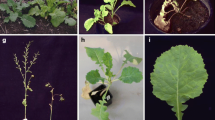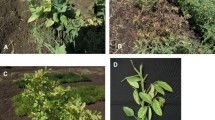Abstract
Soybean dwarf virus (SbDV; family Tombusviridae, genus Luteovirus, species Soybean dwarf virus) can cause damaging disease epidemics in cultivated plants of the family Fabaceae. The biological characteristics of SbDV isolate WA-8, including its vector species, host range, and impact on Australian grain legume cultivars, were investigated in a series of glasshouse experiments. Isolate WA-8 was classified as the YP strain, as it was transmitted by Acyrthosiphon pisum (pea aphid) and Myzus persicae (green peach aphid) and infected known strain indicator species. Of the 18 pasture legume species inoculated with SbDV, 12 were SbDV hosts, including eight that had not been identified previously as hosts. When inoculated with SbDV, field pea (Pisum sativum), faba bean (Vicia faba), lentil (Lens culinaris), and narrow-leafed lupin cv. Jurien were the most susceptible (70 to 100% plant infection rates), and albus lupin (Lupinus albus), chickpea (Cicer arietinum), and narrow-leafed lupin cv. Mandelup were less susceptible (20 to 70%). Over the course of three experiments, chickpea was the most sensitive to infection, with a > 97% reduction in dry above-ground biomass (AGB) and a 100% reduction in seed yield. Field pea cv. Gunyah, faba bean, and lentil were also sensitive, with a 36 to 61% reduction in AGB. Field pea cv. Kaspa was relatively tolerant, with no significant reduction in AGB or seed yield. The information generated under glasshouse conditions in this study provides important clues for understanding SbDV epidemiology and suggests that it has the potential to cause damage to Australian grain legume crops in the field, especially if climate change facilitates its spread.




Similar content being viewed by others
Data availability
The datasets generated during and/or analysed during the current study are available from the corresponding author on reasonable request.
References
Australian Export Grains Innovation Centre (AEGIC) (2020) What grows where? Australian grain production—a snapshot. Australian Grain Note. AEGIC, Sydney
Ashby JW, Teh PB, Close RC (1979) Symptomatology of subterranean clover red leaf virus and its incidence in some legume crops, weed hosts, and certain alate aphids in Canterbury, New Zealand. NZ J Agric Res 22:361–365
Banba H, Tanimura Y, Matuskawa I (1986) Breeding for resistance to soybean dwarf virus in soybeans. Trop Agric Res Ser 19:236–246
Botermans M, van de Vossenberg BTLH, Verhoeven JTJ, Roenhorst JW, Hooftman M, Dekter R, Meekes ETM (2013) Development and validation of a real-time RT-PCR assay for generic detection of pospiviroids. J Virol Methods 187:43–50
Chen C, Lawes R, Fletcher A, Oliver Y, Robertson M, Bell M, Wang E (2016) How well can APSIM simulate nitrogen uptake and nitrogen fixation of legume crops? Field Crops Res 187:35–48
Congdon BS (2021) Soybean dwarf virus in Australia (oral presentation). In: 2021 Australasian Plant Pathology Society Biennial conference 2021, Online event, 23–26 November 2021
Cooper JI, Jones AT (1983) Responses of plant viruses: proposals for the use of terms. Phytopathology 73:127–128
Damsteegt VD, Hewings AD (1987) Relationships between Aulacorthum solani and soybean dwarf virus: effect of temperature on transmission. Phytopathology 77:515–518
Damsteegt VD (1990) Soybean dwarf virus: experimental host range, soybean germplasm reactions, and assessment of potential threat to U.S. soybean production. Plant Dis 74:992–995
Damsteegt VD, Stone AL, Hewings AD (1995) Soybean dwarf, bean leaf roll, and beet western yellows luteoviruses in southeastern U.S. white clover. Plant Dis 79:48–50
Damsteegt VD, Stone AL, Kuhlmann M, Gildow FE, Domier LL, Sherman DJ, Tian B, Schneider WL (2011) Acquisition and transmissibility of U.S. soybean dwarf virus isolates by the soybean aphid, Aphis glycines. Plant Dis 95:945–950
Western Australian Department of Primary Industries and Regional Development (2018) Using summer sowing to introduce serradella into subtropical perennial pastures 2013 trial report. https://www.agric.wa.gov.au/pasture-establishment/using-summer-sowing-introduce-serradella-subtropical-perennial-pastures-2013. Accessed 16 July 2022
Fletcher JD (2001) New hosts of alfalfa mosaic virus, cucumber mosaic virus, potato virus Y, soybean dwarf virus, and tomato spotted wilt virus in New Zealand. NZ J Crop Hortic Sci 29:213–217
Fowkes AR, McGreig S, Pufal H, Duffy S, Howard B, Adams IP, Macarthur R, Weekes R, Fox A (2021) Integrating high throughput sequencing into survey design reveals turnip yellows virus and soybean dwarf virus in pea (Pisum sativum) in the United Kingdom. Viruses 13:2530
Ghosh N, Gotoh K, Nakaseko K, Mori Y (1976) Influence of soybean dwarf virus on growth and yield. Jpn J Crop Sci 45:624–629
Gildow FE, Damsteegt VD, Stone AL, Smith OP, Gray SM (2000) Virus-vector cell interactions regulating transmission specificity of soybean dwarf luteoviruses. J Phytopathol 148:333–342
Harrison B, Steinlage TA, Domier LL, D'Arcy CJ (2005) Incidence of soybean dwarf virus and identification of potential vectors in Illinois. Plant Dis 89:28–32
Helms K, Waterhouse PM, Muller WJ (1985) Subterranean clover red leaf virus disease: effects of temperature on plant symptoms, growth, and virus content. Phytopathology 75:337–341
Helms K, Müller WJ, Waterhouse PM (1987) Subterranean clover red leaf virus disease: effects of light intensity on plant symptoms, growth, and virus content. Phytopathology 77:1297–1300
Helms K, Muller W, Waterhouse P (1993) National survey of viruses in pastures of subterranean clover. I. Incidence of four viruses assessed by ELISA. Aust J Agric Res 44:1837–1862
Hewings AD, Damsteegt VD, Sindermann AE, Tolin SA (1990) Variations in serologically detectable antigen of soybean dwarf virus in soybean leaflets as a function of time after inoculation and plant age. Plant Dis 74:844–848
Honda K, Kanematsu S, Mikoshiba Y (1999) Dwarfing strain of soybean dwarf luteovirus transmitted by Nearctaphis bakeri and Acyrthosiphon pisum. Ann Phytopathol Soc Jpn 65:387
Johnstone G, Duffus J (1984) Some luteovirus diseases in Tasmania caused by beet western yellows and subterranean clover red leaf viruses. Aust J Agric Res 35:821–830
Johnstone GR (1978) Diseases of broad bean (Vicia faba L. major) and green pea (Pisum sativum L.) in Tasmania caused by subterranean clover red leaf virus. Aust J Agric Res 29:1003–1010
Johnstone GR, Rapley PEL (1979) The effect of time of sowing on the incidence of subterranean clover red leaf virus infection in broad bean (Vicia faba). Ann Appl Biol 91:345–351
Johnstone GR (1983) The reactions of subterranean clover to inoculation with two persistent aphid transmitted viruses. In: Proceedings of the international working group on legume viruses, Binnu Burra, Queensland. Queensland Department of Primary Industries, Brisbane, pp 7–8
Johnstone GR, Ashby JW, Gibbs AJ, Duffus JE, Thottappilly G, Fletcher JD (1984) The host ranges, classification and identification of eight persistent aphid-transmitted viruses causing diseases in legumes. Neth J Plant Pathol 90:225–245
Johnstone GR, Barbetti MJ (1987) Impact of fungal and virus diseases on pasture. In: Wheeler JL, Pearson CJ, Roberts GE (eds) Temperate pastures: their production, use and management. Australian Wool Corporation/CSIRO, Melbourne, pp 235–248
Johnstone GR, McLean GD (1987) Virus diseases of subterranean clover. Ann Appl Biol 110:421–440
Jones RAC (2004) Occurrence of virus infection in seed stocks and 3-year-old pastures of lucerne (Medicago sativa). Aust J Agric Res 55:757–764
Jones RAC (2012) Virus diseases of annual pasture legumes: incidences, losses, epidemiology, and management. Crop Pasture Sci 63:399–418
Jones RAC, Barbetti MJ (2012) Influence of climate change on plant disease infections and epidemics caused by viruses and bacteria. CAB Rev 7:1–33
Kellock A (1971) Red-leaf virus—a newly recognized virus disease of subterranean clover (Trifolium subterraneum L.). Aust J Agric Res 22:615–624
Makkouk K (2001) Viruses on cultivated forage legumes in Syria. Arab J Plant Prot 19:73–79
Makkouk K, Kumari S, Shahraeen N, Fazlali Y, Farzadfar S, Ghotbi T, Mansouri A (2003) Identification and seasonal variation of viral diseases of chickpea and lentil in Iran. J Plant Dis Prot 110:157–169
Makkouk KM, Kumari SG (2001) Reduction of incidence of three persistently transmitted aphid-borne viruses affecting legume crops by seed-treatment with the insecticide imidacloprid (Gaucho®). Crop Prot 20:433–437
McKirdy S, Jones R (1995) Occurrence of alfalfa mosaic and subterranean clover red leaf viruses in legume pastures in Western Australia. Aust J Agric Res 46:763–774
Meat and Livestock Australia (2020) The economic significance of Australia’s red meat and livestock industry. https://www.mla.com.au/prices-markets/market-news/2020/the-economic-significance-of-australias-red-meat-and-livestock-industry/. Accessed 10 Feb 2022
Menzel W, Jelkmann W, Maiss E (2002) Detection of four apple viruses by multiplex RT-PCR assays with coamplification of plant mRNA as internal control. J Virol Methods 99:81–92
Mikoshiba Y, Fujisawa I, Honda K (1991) A new strain of soybean dwarf virus transmitted by Acyrthosiphon pisum in Japan. Ann Phytopathol Soc Jpn 57:448
Ng JC, Perry KL (2004) Transmission of plant viruses by aphid vectors. Mol Plant Pathol 5:505–511
Nichols PGH, Revell CK, Humphries AW, Howie JH, Hall EJ, Sandral GA, Ghamkhar K, Harris CA (2012) Temperate pasture legumes in Australia—their history, current use, and future prospects. Crop Pasture Sci 63:691–725
Peter A, Shanower T, Romeis J (1995) The role of plant trichomes in insect resistance: a selective review. Phytophaga 7:41–64
Philippi J, Schliephake E, Jürgens H-U, Jansen G, Ordon F (2015) Feeding behavior of aphids on narrow-leafed lupin (Lupinus angustifolius) genotypes varying in the content of quinolizidine alkaloids. Entomol Exp Appl 156:37–51
Sanford P, Congdon BS, Foster KJ (2021) Identifying the cause of recent outbreaks of subterranean clover red leaf syndrome in Western Australia. In: Australian Grassland Association virtual symposium 2021, 10–31 March 2021
Schneider WL, Damsteegt VD, Stone AL, Kuhlmann M, Bunyard BA, Sherman DJ, Graves MV, Smythers G, Smith OP, Hatziloukas E (2011) Molecular analysis of soybean dwarf virus isolates in the eastern United States confirms the presence of both D and Y strains and provides evidence of mixed infections and recombination. Virology 412:46–54
Tamada T (1970) Aphid transmission and host range of soybean dwarf virus. Ann Phytopathol Soc Japan 36:266–274
Tamada T (1973) Strains of soybean dwarf virus. Ann Phytopathol Soc Jpn 39:27–34
Terauchi H, Kanematsu S, Honda K, Mikoshiba Y, Ishiguro K, Hidaka S (2001) Comparison of complete nucleotide sequences of genomic RNAs of four soybean dwarf virus strains that differ in their vector specificity and symptom production. Arch Virol 146:1885–1898
Terauchi H, Honda K-I, Yamagishi N, Kanematsu S, Ishiguro K, Hidaka S (2004) The N-terminal region of the readthrough domain is closely related to aphid vector specificity of soybean dwarf virus. Phytopathology 93:1560–1564
Wilson J, Close RC (1973) Subterranean clover red leaf virus and other legume viruses in Canterbury. NZ J Agric Res 16:305–311
Acknowledgments
This study was funded by the Department of Primary Industries and Regional Development (DPIRD) and Grains Research and Development Corporation project DAN00202 led by Dr. Joop van Leur (New South Wales Department of Primary Industries). We thank Jenny Reidy-Crofts (Commonwealth Scientific and Industrial Research Organisation) for provision of pea aphid clone Flor-1, and Paul Sanford (DPIRD) for original collection of SbDV isolate WA-8.
Funding
The authors have not disclosed any funding.
Author information
Authors and Affiliations
Contributions
Design of experiments, data analysis, and writing of the manuscript were done by B. Congdon. Glasshouse experiments, virus testing, and data collection were done by B. Congdon and J. Baulch. K. Foster provided seed of pasture legume species in experiment 2 and editing of manuscript.
Corresponding author
Ethics declarations
Conflict of interest
The authors have no relevant financial or non-financial interests to disclose.
Additional information
Handling Editor: Massimo Turina.
Publisher’s Note
Springer Nature remains neutral with regard to jurisdictional claims in published maps and institutional affiliations.
Electronic Supplementary Material
Below is the link to the electronic supplementary material
Rights and permissions
Springer Nature or its licensor (e.g. a society or other partner) holds exclusive rights to this article under a publishing agreement with the author(s) or other rightsholder(s); author self-archiving of the accepted manuscript version of this article is solely governed by the terms of such publishing agreement and applicable law.
About this article
Cite this article
Congdon, B.S., Baulch, J.R. & Foster, K.J. Vector species, pasture legume host range, and impact on grain legumes of an Australian soybean dwarf virus isolate. Arch Virol 168, 20 (2023). https://doi.org/10.1007/s00705-022-05664-8
Received:
Accepted:
Published:
DOI: https://doi.org/10.1007/s00705-022-05664-8




